The Garmin Venu is a multisport GPS smart health connected watch offering the features of the Garmin Vivoactive 4 (in particular an ultra-complete monitoring of health and activity and animated exercises to do the movements well) but equipped with a AMOLED screen, a first at Garmin. The technology is already used by Apple and Samsung on their Smartwatch, the Apple Watch and the Samsung Galaxy Watch.
What is an AMOLED screen?
The AMOLED screen (from the English Active-Matrix Organic Light-Emitting Diode or, in French, active matrix with organic light-emitting diodes) is an alternative solution to the LCD invented in the 90s. It is used in most Smartphones and more and more in televisions (the first television with AMOLED is marketed by Sony in 2007).
Instead of using liquid crystals which let or not pass the light emitted by a backlight located behind the panel (LCD technique), it uses OLEDs, an improved version of LED (light emitting diode). The OLEDs are controlled by a matrix called “Active” (AM), the solution already used on the LCDs (each pixel is controlled individually).
Why use an AMOLED screen on a smart health connected watch?
The AMOLED screen offers a much better display quality than that of a conventional watch screen or even an LCD screen. The screen is brighter, the display more fluid, the rendering exceptional, the colors shimmering and the blacks very deep thanks to an infinite contrast linked to technology (the OLEDs are either on or off: there is no light leakage as on LCD screens).
On a MIP (Memory In Pixel) cardio watch screen, the color palette is limited (64 colors in general), resulting in poor rendering of photos and animations. AMOLED does not have these limitations. It therefore displays gradients and images and animations rich in color. This is the interest of this screen on the Garmin Venu which precisely offers animations in its watchfaces and animated exercises.
AMOLED technology also makes it possible to obtain high resolutions (number of pixels per cm2). That of the Venu is 390 x 390 px, or 2.5 times more than the Vivoactive 4 whose screen is nevertheless larger! The images and animations are therefore perfectly clear.
AMOLED offers an excellent response time (0.1 ms compared to 2 ms and more for LCD screens) and a wide viewing angle. The absence of backlighting greatly reduces the power consumption of the screen (an asset for Smartphones) and makes it possible to obtain ultra-thin screens (less than 5 mm thick).
The energy consumption of AMOLEDs screens remains however higher than that of transflective MIP screens of cardio watches: OLEDs consume when they are switched on while on a MIP screen, ambient light replaces the backlight, the latter being used only ” in case of insufficient outside light. In addition, the lifespan of AMOLEDs is still low (around 50,000 hours) compared to that of LCD screens, but the limits are pushed back each year.
Characteristics of the Garmin Venu
46.3 g
Dimensions
43.2 x 43.2 x 12.4 mm
Screen
AMOLED touchscreen, color, 390 x 390 px
Autonomy
8 p.m. in GPS mode, 5 days in watch mode with 24-hour tracking
GPS
GPS, GLONASS, Galileo
Multisports
Yes, but without managing transitions (triathlon, etc.)
Recommended activities
20 sports profiles (more on Garmin), including indoor sports, golf, yoga, Pilates
Connectivity
Wireless Bluetooth Smart data transfer.
Heart rate monitoring
Yes, optical on the wrist
Topographic maps
–
Music player
Yes (500 titles)
Yes, Garmin Pay
Telephony / 4G
–
Barometric altimeter
Yes
Barometer
–
Compass
Yes
Thermometer
Yes
Weather forecast
Yes (with smartphone pairing)
Waterproof
5 ATM (swim)
Other
Pulse oximeter, animated exercises, numerous health monitoring functions (stress, hydration, menstrual cycle, recovery, sleep, blood oxygen, etc.), VO2max, activity monitoring, relaxation exercises including cardiac coherence, Smartphone notifications.
Garmin Venu review, a smart health connected watch that tracks your health closely
Who is the Garmin Venu for?
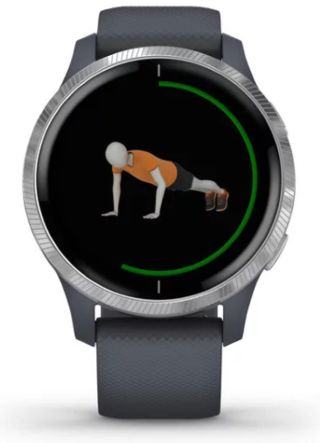
The Garmin Venu is a sporty, smart health connected and multisport GPS watch intended to accompany people who play sports occasionally and / or who want to monitoring their health closely.
Whether you are a sportsperson or not, it monitors daily activity, 24 hours a day, and displays valuable health information (monitoring heart rate, stress, breathing, hydration, sleep, recovery, menstrual cycle and more). It also provides relaxation exercises based on breathing.
Animated exercises allow you to learn how to perform yoga, pilates, bodybuilding or cardio training movements. It records sports outings and summarizes key figures, the route and practical information.
It also has Garmin Pay, a contactless payment method, and an mp3 player to listen to music without having to carry a smartphone.
Garmin Venu: a Vivoactive 4 with an AMOLED screen
The Venu offers exactly the same functions as the Garmin Vivoactive 4 (same software). The only difference is in the watch screen, the design and the autonomy.
We summarize below its main functions. For a more detailed review, we invite you to consult our detailed review of the Garmin Vivoactive 4.
Design and technical characteristics
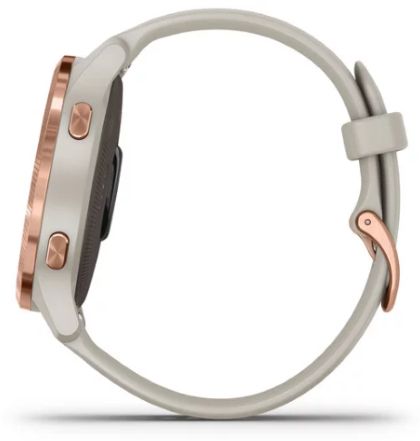
Garmin offers an elegant design similar to that of the Vivoactive for its smart health connected watch: reinforced polymer case, stainless steel bezel, Corning Gorilla 3 glass and interchangeable silicone strap without tools. Its ribbed bezel gives it a nice effect.
Unlike the Vivoactive 4, offered in 2 case sizes (a small case for fine wrists and a standard case for other wrists), it only exists in one size (43.2 mm in diameter) and weighs only 46.3 g. It is in a way an intermediate model in the Vivoactive 4S and the Vivoactive 4.
Its water resistance of 5 ATM (5 bars) allows use for swimming but not for diving.
| Characteristics | Garmin came | Vivoactive 4S | Vivoactive 4 |
|---|---|---|---|
| Glass | Corning Gorilla 3 | Corning Gorilla 3 | Corning Gorilla 3 |
| Housing material | Fiber-reinforced polymer | Fiber-reinforced polymer | Fiber-reinforced polymer |
| Glasses | Stainless steel | Stainless steel | Stainless steel |
| Case diameter | 43.2 mm | 40 mm | 45 mm |
| Case thickness | 12.4 mm | 12.7 mm | 12.8mm |
| Screen size | 30.3 mm | 27.9mm | 33 mm |
| Wrist circumference | 125-190 mm | 110-175mm | 135-200 mm |
| Display size | 30.3 mm | 27.9mm | 33 mm |
| Definition | 390 x 390 px | 218 x 218 px | 260 x 260 px |
| Weight | 46.3 g | 40 g | 50.5 g |
| Bracelet width | 20 mm | 18 mm | 20 mm |
The sensors
We find on the Venu all the Vivoactive 4 sensors: optical wrist heart rate monitoring, GPS (GPS, GLONASS and Galileo compatible), pulse oximeter (SpO2), barometric altimeter, thermometer, compass, accelerometer, gyroscope.
The AMOLED screen: exceptional rendering and colorful animations
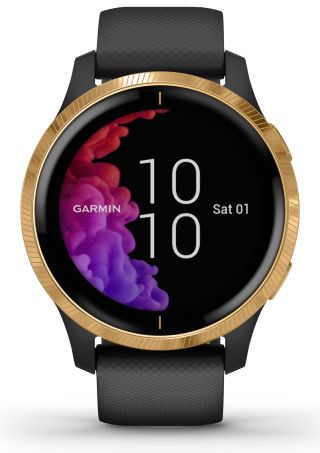
The big difference of this model with the Vivoactive 4 is of course its AMOLED screen. The 1.2 “display offers a large palette of colors (only 64 on the Vivoactive 4, a limitation linked to the MIP screen) and a very high resolution suitable for displaying animations and photos: 390 x 390 px, or 3 times more pixels than the Vivoactive 4S (218 x 218 px and 1.1 “) and 2.5 more than the Vivoactive 4 (260 x 260 px and 1.3”).
The AMOLED screen is readable even in direct sunlight and offers a high-quality display that is found on the Apple Watch and many smartphones. Garmin offers colorful animations and high-quality watchfaces.
Although less energy intensive than an LCD screen, the AMOLED consumes more than the transflective screen of the Vivoactive 4 (read our explanations at the beginning of the article). Garmin however offers excellent autonomy for this watch (see below).
Autonomy: excellent with disengageable display
The drawback of the AMOLED screen on a cardio watch is its power consumption, which is greater than that of a transflective screen. OLEDs indeed consume energy where the transflective screen uses ambient light.
Garmin nevertheless announces an autonomy very close to that of the Vivoactive 4 with 5 days in smart health connected watch mode and 6 h in GPS + music mode, which is rather good news. In comparison, the Apple Watch 4, with AMOLED screen, offers only 18 hours of autonomy!
To save battery, the screen display is not permanent. The simple rotation of the wrist to watch the watch automatically reactivates it. For greater autonomy, Garmin advises to avoid animations, to decrease the brightness of the screen and to shorten the display time.
But the advantage of this model is to offer permanent display as an option. We can therefore force the display of the data permanently. The wallpaper automatically disappears after a few seconds. This battery mode greatly reduces the autonomy: we go from 5 days to 2 to 3 days maximum.
| Fashion | Garmin came | Vivoactive 4S | Vivoactive 4 |
|---|---|---|---|
| smart health connected watch + activity tracking | 5 d | 7 days | 8 days |
| Watch + music | 7.5 h | 6 a.m. | 7.5 h |
| GPS mode | 8 p.m. | 3 p.m. | 6 p.m. |
| GPS + music mode | 6 a.m. | 5 a.m. | 6 a.m. |
| Activity mode + animated exercises | 8 a.m. | 8 a.m. | 9.5 hrs |
| Activity mode + animated exercises + music | 4 hrs | 3.5 hrs | 4.5 hrs |
Fonctionnalities
We find on the Garmin Venu the same features as those of the Vivoactive 4. You will find all the details in our detailed review of the Vivoactive 4.
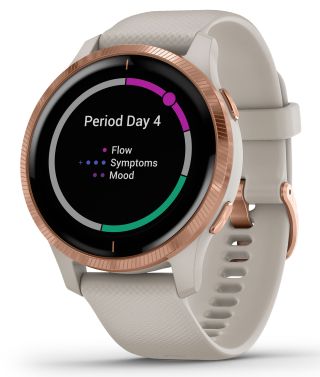
- Health monitoring the most complete that exists on a cardio watch: in-depth monitoring of sleep, stress, the menstrual cycle, breathing, hydration, blood oxygen saturation (SpO2). The watch also offers a Body Battery function constantly evaluating the body’s energy reserve to know how to recover and whether one is ready for a sporty outing.
- Sports functions provided with more than 20 sports profiles (more downloadable on Garmin), recording of the courses, the possibility of programming training sessions, training sessions available for the race (5 and 10 km, half-marathon, marathon), programming objectives and alerts on the watch, the estimate of the VO2max and the running time for a 10 km or marathon for example.
- Animated exercises (mini videos) for yoga, Pilates, bodybuilding and cardio. They offer exercises that are easy to perform and show how to perform the movements well.
- GPS navigation to reach a saved point or return to the starting point of its exit.
- Garmin Pay , a contactless payment solution to pay for purchases without having to take out a credit card or a Smartphone
- An mp3 player and a storage capacity of 500 musical titles. The watch can be used with Bluetooth wireless headphones to listen to music without having to carry a smartphone. The Venu provides access to the major online music platforms: Deezer, Spotify or Amazon Music.
- An activity tracker to complete health monitoring: number of steps, intensive minutes, climbing steps, calories burned
- smart health connected functions: email and SMS notifications, weather, calendar, etc.
- Fall detection and incident assistance (call an SOS number and transmit the GPS position).
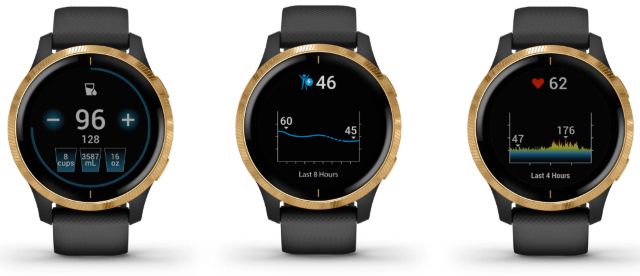
Our opinion
A magnificent screen, very complete functions but a model little adapted to fine wrists
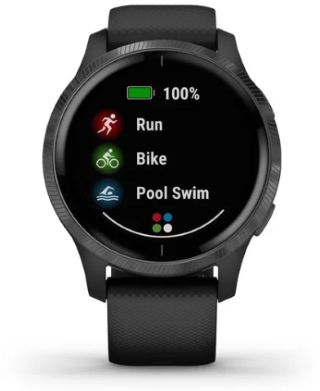
The Garmin Venu offers the same functions as the Vivoactive 4 (our favorite of smart health connected watches for the richness of its functions and its sensors and an attractive price) with, in addition, an AMOLED screen with a truly superb rendering reminiscent of that of the ‘Apple Watch. This screen allows you to display, with remarkable quality, animations and photos. All of this has a nice effect at the office or with friends …
This watch nevertheless costs € 50 more than the Vivoactive 4 for a beautiful screen, of course, but a slightly lower autonomy (even if it remains higher than most competing AMOLED watches) and a case size a little big for thin cuffs.
We remain however seduced by this new model which stands out from the crowd and comes to compete with Apple and Samsung. Garmin can become a serious competitor in the Smartwatch market with a big lead on the sports functions which are the most complete to date on the market and can make the difference on this type of watch.
For sporty people practicing a regular activity, it would be better to opt for a more sport-oriented model like the Forerunner series from Garmin.
Vivoactive 4 or Venu: which one to choose?
The 2 watches are identical in terms of functionality and sensors. The only difference is in the screen (transflective MIP versus AMOLED), the size of the watch, its autonomy and the price. The choice must be made at this level.
If budget is not an issue, the Garmin Venu is clearly an interesting watch for its extraordinary display. It will be necessary to do with a lower autonomy or then deactivate the permanent display. This watch is also a little voluminous on a small wrist.
Also note that the lifespan of AMOLED screens is shorter than that of an LCD or MIP screen. To extend the life of the screen, Garmin recommends that you avoid displaying still images at high brightness levels for long periods of time. Better to be warned.
For a person with fine wrists, the Garmin Vivoactive 4S will be better suited with its small 40 mm case, more suitable (see also our comparison of the best watches for women). Similarly, if you want a permanent display but with the best possible autonomy, it is also better to choose the Vivoactive.
- The exceptional display of the AMOLED screen
- The health monitoring functions (the most comprehensive that exist)
- Over 40 animated exercises (mini videos to learn how to do the movements well)
- Very complete sensors
- The on-board mp3 player and the payment solution
- The weight of the watch (ultra-light)
- A model suitable for thin wrists (like the Vivoactive 4)
Best price of Garmin venu and availability
The Garmin Venu is available for sale at a suggested retail price of €$339.99. Find out from our partners below with best price $229.








